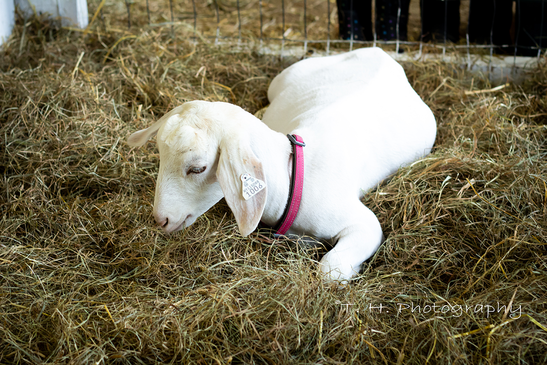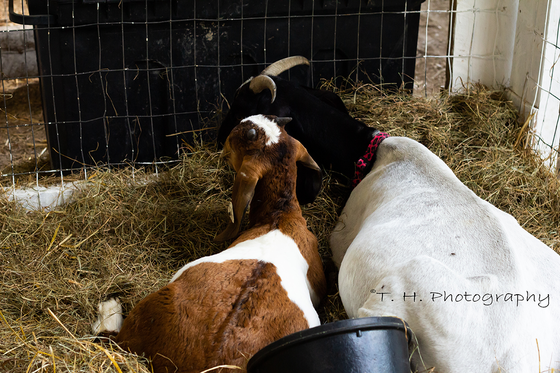|
This little white lady is resting after a busy day at the St. Lawrence County Fair. What is CAE? That is an abbreviation in the goat world that rides the breeze like a whisper. CAE is known as Caprine Arthritic Encephalitis. Some have even heard of it called the Silent Killer. Isn't that a terrible name? To us it brings images of sleeping and having something dark and hideous creeping up on you. All the while you are there completely unaware what is around you. CAE can be found in Africa, Australia, Europe, New Zealand, and North America. Here is the hard fact that only a percentage of people who own goats are aware of the diseases that goats have or how contagious these diseases are. Hardy as a goat, right. Nope! No such truth in that. These creatures take a lot of proper care and diet. It is all worth the work when you meet them and fall in love with their personalities. That might be the big part of why, for those that do know about this disease, it is so hard not to keep the animal, continue breeding, because we do fall in love with them. It isn't easy to spot CAE in all goats. Most goats can live their entire life out with out showing one single symptom at all. If a goat doesn't appear to be sick, then what is the problem? The problem comes for those who do show symptoms. A young kid goat who is infected with CAE can have awful encephalitic seizures that will kill them. It is more often that goats show symptoms in their adult years. This girl wasn't fazed at all with us coming around. She continued browsing. This disease is a retro-virus. A retro-virus is any group of RNA viruses that insert a DNA copy of their genome into the host cell in order to replicate it. What does this mean in English? It means that a goat who is CAE-positive does not have the antibodies to fight off this disease. Caprine Arthritis Encephalitis is a lot like our human version of AIDS, which is another retro-virus. CAE can not be passed to humans. Consuming the milk or meat of a CAE infected animal is safe. Caprine Arthritis Encephalitis can be found in both dairy and meat goats. It doesn't discriminate. Just like AIDS doesn't discriminate from men to women. Now, there are many ways to transfer CAE from goat to goat. The percentage of some are higher than others. Though, the studies of what percents are accurate are still going on. How is Caprine Arthritis Encephalitis Transfered:
*This disease is transferred through white-blood cells. Any bodily fluid that contains white-blood cells can transfer the disease. **How can we get try to prevent the passing from doe to kid? We'll get to that in Help Prevent CAE...Part 3. There are at least five types of CAE. They are Arthritic CAE, Encephalitic CAE, Pneumonic CAE, and Mastitic CAE. Each one of these has slightly different symptoms. None of them are curable. There have been studies that some goat owners are using resources to help manage CAE. That will be in the Help Prevent CAE...Part 3. Arthritic CAE: shows symptoms that consist of walking on knees, swollen joints, weight loss, reluctance to walk, abnormal posture, stiffness, reluctance to rise, and lameness. Encephalitic CAE: shows symptoms that consist of head tilt, blindness, depression, in-coordination, progressive paralysis, seizures, and inappropriate placement of limbs. This is mostly found in young kid goats. The seizures are deadly. Pneumonic CAE: shows symptoms that consist of weight loss, deep chronic cough, and difficulty breathing. Mastitic CAE: shows symptoms that consist of hard, swollen udders and decreased milk production. *Chronic wasting disease is included in this disease category. It could show up in an effected goat by itself or with one of the other CAEs. Each one of these is painful and reduces the quality of life for the goats that have it. Saddening really. Plus, if you are a dairy goat farm, the reduction of the milk can hurt your production by a lot. Again, CAE isn't passed to humans and can not harm them if they consume milk or meat from an infected goat. A mother and kid boar goats. Love the color of the kid. This disease truly saddens us. It is not hard to eradicate it. However, the ways of cleaning a herd up is to cull the infected goats. If a goat has something that can cause suffering wouldn't it be better to not let it get to that point or to not pass it on to the next generation? We don't like animals suffering here on our farm. It is our mission to provide them with the best possible life we can. With that being said in all good faith it is against what we believe to pass on infected goats. This just keeps the vicious cycle going. Please research and ask the breeder questions. Be sure if they say that they have a clean herd, you see the papers proving the herd is clean. When were they tested last? Did they take the animals to shows after testing? Has any new animals arrived at their farm since testing? Were those animals tested before or after they arrived? It might seem like a million questions, however, a breeder who really cares for the health and livelihood of their goats will answer these questions for you. In truth, those goats they are selling are their business. They have worked hard for them. Their name is on the registration papers. So please ask away. Below are a few links. Be on the look out for the final section covering this disease, Help Prevent CAE...Part 3.
0 Comments
Leave a Reply. |
Kimberly Doerr
|



 RSS Feed
RSS Feed